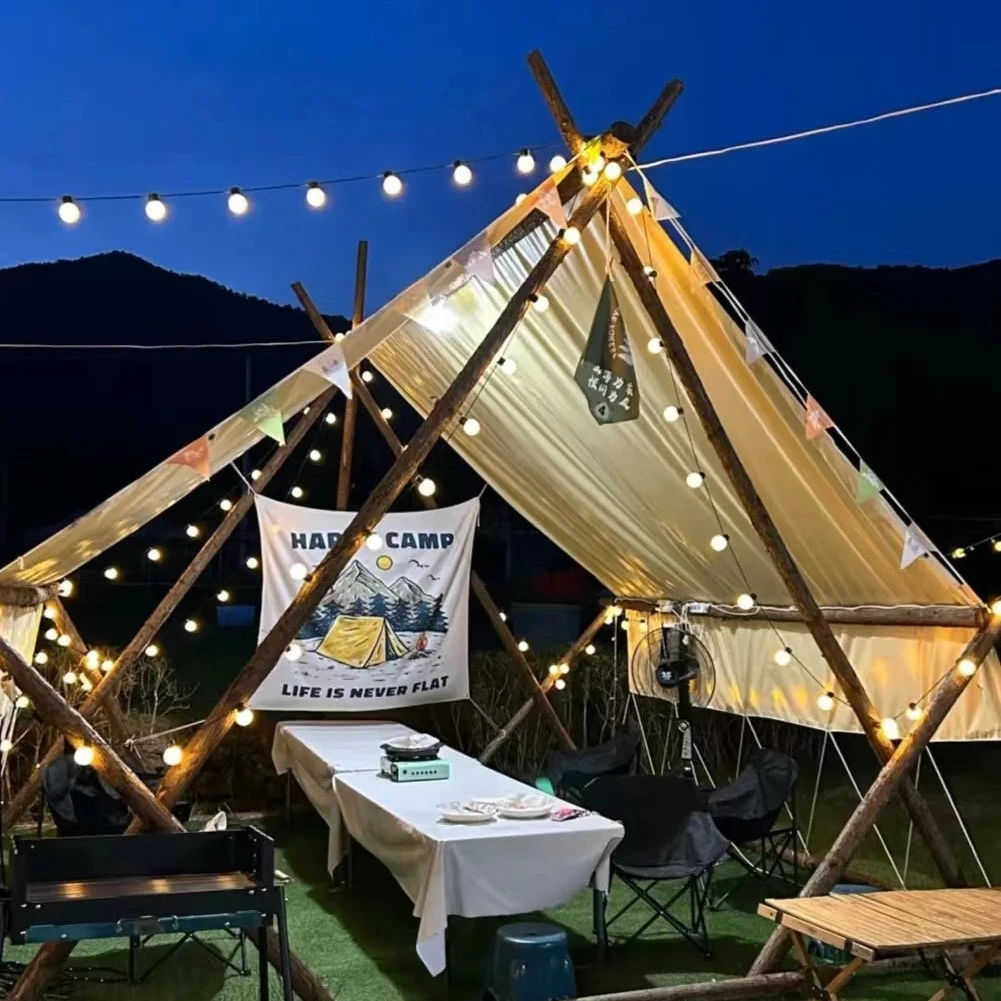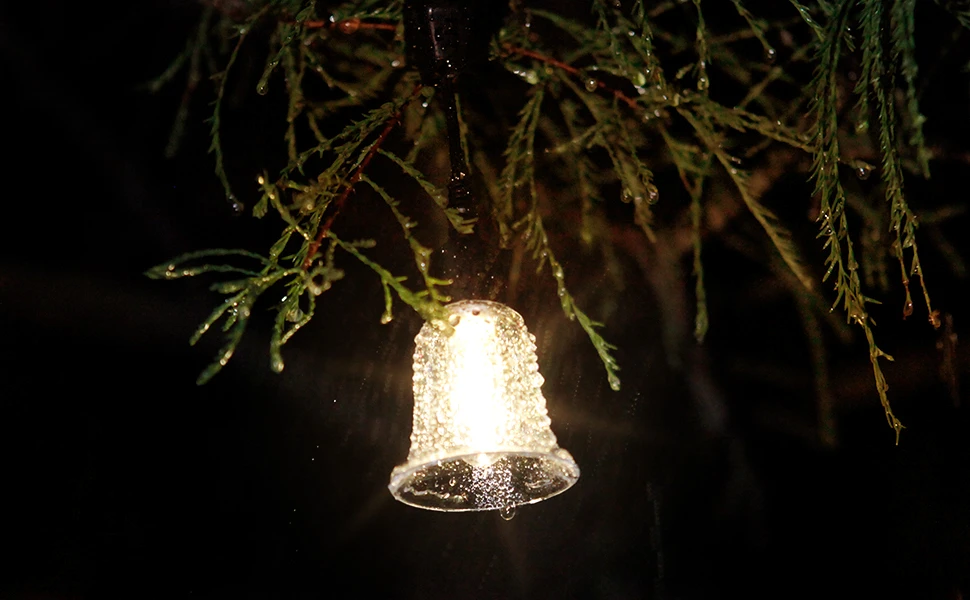Solar rope lights have surged in popularity as a versatile and eco-friendly solution for outdoor lighting, transforming patios, gardens, and walkways with their flexible, tube-like design. Powered by solar energy, these lights offer a sustainable alternative to traditional electric lighting, but their outdoor use exposes them to rain, humidity, and other elements. This raises a critical question: Are waterproof solar rope lights worth the investment? This article explores the features, advantages, and practical considerations of waterproof solar lights, providing guidance to help you choose the right product for your outdoor space.

What Are Waterproof Solar Rope Lights?
Solar rope lights consist of LED strips encased in a flexible, transparent or colored plastic tube, powered by a solar panel that charges a rechargeable battery. The “waterproof” designation refers to their ability to resist moisture, typically indicated by an IP rating (Ingress Protection). For outdoor use, IP65 waterproof or higher ratings are common, protecting against water jets (IP65), temporary submersion (IP67), or prolonged submersion (IP68). These lights are designed to withstand rain, sprinklers, and humidity, making them ideal for sustainable lighting in challenging environments.
Unlike standard solar-powered lights, waterproof solar rope lights feature sealed components, including the solar panel, solar battery, and LED strip, to prevent corrosion or electrical failure. Their flexibility allows them to be wrapped around trees, railings, or fences, offering both functional and decorative outdoor lighting.
Key Features of Waterproof Solar Rope Lights
The appeal of waterproof solar rope lights lies in their unique combination of features, tailored for outdoor durability and aesthetic versatility:
- High IP Ratings: An IP65 waterproof rating or above ensures protection against water and dust, critical for year-round outdoor use.
- Durable Materials: UV-resistant PVC or silicone tubing protects the LED strip from sun exposure and moisture, preventing cracking or yellowing.
- Efficient Solar Panels: Monocrystalline solar panels (15-22% efficiency) charge effectively in direct sunlight, ensuring reliable performance.
- Long-Lasting Batteries: Lithium-ion batteries provide 8-12 hours of illumination, even after partial charging in cloudy conditions.
- Flexible Design: The bendable tube allows creative installations, from outlining pathways to accenting garden features.
- Smart Features: Many models include dusk-to-dawn sensors, motion detection, or color-changing modes for enhanced functionality.
These features make waterproof solar lights a robust choice for outdoor lighting, but their value depends on specific advantages and practical considerations.
Advantages of Waterproof Solar Rope Lights
1. Enhanced Durability in Harsh Weather
The primary advantage of waterproof solar rope lights is their resilience. An IP65 waterproof rating or higher protects against rain, snow, and humidity, reducing the risk of corrosion in the solar panel or solar battery. User reviews on Bitpott note that IP67-rated lights can survive heavy downpours or coastal salt spray, lasting 2-3 years longer than non-waterproof models. This durability ensures consistent solar light efficiency in diverse climates.
2. Eco-Friendly and Cost-Effective
By harnessing solar energy, these lights eliminate electricity costs and reduce your carbon footprint. The initial investment (typically $20-$50 for a 16-50ft strand) is offset by zero operating costs. Lithium-ion batteries and efficient LED strips minimize energy waste, making them a cornerstone of sustainable lighting.
3. Versatile Aesthetic Appeal
Solar rope lights offer unmatched flexibility for creative outdoor lighting. Wrap them around pergolas, line pathways, or drape them over shrubs for a warm, inviting glow. Models with color-changing LED lights add festive flair for holidays or events. Their low-profile design blends seamlessly into landscapes, enhancing curb appeal without clutter.
4. Easy Installation and Low Maintenance
No wiring or electrical expertise is required to install waterproof solar rope lights. Simply mount the solar panel in a sunny spot, secure the rope with clips or ties, and let the dusk-to-dawn sensor handle operation. Maintenance involves occasional cleaning of the solar panel to ensure optimal solar energy capture, a task that takes minutes monthly.
5. Safety and Reliability
Unlike electric lights, solar-powered lights pose no risk of electrical shock, making them safe for homes with children or pets. Waterproofing further enhances reliability by protecting against moisture-related failures, ensuring consistent illumination even during wet seasons.
Potential Drawbacks to Consider
While waterproof solar rope lights offer significant benefits, they’re not without limitations:
- Sunlight Dependency: Performance relies on direct sunlight for charging. In shaded or cloudy areas, solar light efficiency may drop, resulting in dimmer or shorter illumination (4-6 hours vs. 8-12 in full sun).
- Initial Cost: IP65 waterproof or higher models are pricier than non-waterproof lights, though long-term savings offset this.
- Battery Lifespan: Rechargeable batteries typically last 1-2 years before needing replacement, adding a minor maintenance cost.
- Brightness Limitations: Most solar rope lights produce 1-5 lumens per foot, suitable for ambient lighting but not for task or security purposes.
User discussions on Bitpott highlight that choosing high-quality models with monocrystalline solar panels and lithium-ion batteries mitigates these drawbacks, but careful selection is key.

Are They Worth the Investment?
Waterproof solar rope lights are worth it for most outdoor applications, particularly if you prioritize durability, eco-friendliness, and aesthetic versatility. They excel in regions with frequent rain or humidity, where IP65 waterproof or higher ratings ensure longevity. For homeowners seeking low-maintenance, sustainable lighting, the zero operating costs and easy installation make them a compelling choice. However, they may not suit yards with heavy shade or those requiring high-intensity lighting, where grid-powered alternatives might be better.
To determine their value for your space, assess your sunlight availability, weather conditions, and lighting goals. If your yard receives 6-8 hours of direct sunlight and you need ambient or decorative lighting, waterproof solar lights are a smart investment.
How to Choose the Best Waterproof Solar Rope Lights
Selecting the right solar rope lights involves evaluating several factors to match your outdoor space:
1. Verify IP Rating
Choose lights with an IP65 waterproof rating or higher. For areas with heavy rain or sprinklers, opt for IP67 or IP68 to ensure protection against submersion. Check manufacturer specifications and user reviews to confirm water resistance.
2. Prioritize Quality Components
Look for monocrystalline solar panels for superior solar light efficiency and lithium-ion batteries for longer runtime and durability. Avoid models with amorphous panels (6-8% efficiency) or Ni-MH batteries, which underperform in low light.
3. Assess Brightness and Length
Consider your lighting needs: 1-2 lumens per foot for subtle glow, 3-5 for brighter ambiance. Measure your space to choose the right length (16-100ft options are common). Models with adjustable brightness or color modes offer flexibility.
4. Check Material Durability
Select solar rope lights with UV-resistant PVC or silicone tubing to prevent cracking or fading. Ensure the solar panel is coated with waterproof resin or tempered glass for added protection.
5. Evaluate Smart Features
Features like motion sensors, timers, or remote controls enhance usability. Dusk-to-dawn sensors are standard, but motion detection can save energy in low-traffic areas.
6. Read User Feedback
Platforms like Bitpott reveal real-world performance. Look for reviews on solar light durability, ease of installation, and performance in wet or shaded conditions to avoid overhyped products.
Practical Tips for Installation and Maintenance
To maximize the performance of waterproof solar rope lights, follow these tips:
- Optimize Solar Panel Placement: Mount the solar panel in a spot with 6-8 hours of direct sunlight, facing south in the Northern Hemisphere. Use extension cables if needed to avoid shading.
- Secure the Rope: Use clips, zip ties, or adhesive strips to fasten the LED strip along railings or paths, ensuring it stays in place during wind or rain.
- Clean Regularly: Wipe the solar panel monthly with a soft cloth and mild detergent to remove dust or debris, boosting solar energy capture by up to 30%.
- Inspect Seals: Check the solar battery compartment and connectors for tight seals. Apply silicone sealant if gaps appear to enhance waterproofing.
- Protect in Extreme Weather: Cover or store lights during hurricanes or heavy snow to extend solar light durability.
- Replace Batteries: Swap rechargeable batteries every 1-2 years to maintain runtime, especially in high-use settings.
Real-World Examples
- Coastal Patio: A homeowner in San Diego used IP68-rated solar rope lights to outline a seaside patio. The lights withstood salt spray and rain, providing 8 hours of warm glow nightly after adding silicone sealant to connectors.
- Garden Pathway: In Seattle, a gardener wrapped IP65 waterproof lights around trellises. Despite frequent drizzle, biweekly cleaning of the solar panel ensured 6-8 hours of illumination.
- Holiday Decor: A Texas family used color-changing solar rope lights for festive fence decor. The IP67 rating and lithium-ion battery maintained performance through winter storms, per Bitpott feedback.
These examples show that waterproof solar lights can thrive in diverse settings with proper care.
Conclusion
Waterproof solar rope lights are a worthwhile investment for most outdoor spaces, offering durability, eco-friendliness, and versatile outdoor lighting. Their IP65 waterproof or higher ratings protect against moisture, while monocrystalline solar panels and lithium-ion batteries ensure reliable performance. By choosing high-quality models, optimizing installation, and maintaining components, you can enjoy sustainable lighting that enhances your yard’s beauty and functionality. Whether illuminating a coastal walkway or a backyard pergola, solar rope lights provide a cost-effective, stylish solution for harnessing solar energy in any weather.


Leave a Reply